|
About a year ago, I received the news that Leupold was replacing
their superb Vari-X III scopes with a new line. This seemed wrong to me. It
would be like hearing that Winchester was replacing the model 94 or
that Mama was changing her biscuit recipe. Some things you just donít
mess with.
At the 2004 SHOT Show in Las Vegas
a couple of months later, Leupold displayed the replacement for the Vari-X
III. The new line of scopes was designated the VX-III, and offered some
interesting changes. Some of the changes included a new lens system
for improved light transmission, easier to use finger adjustable turrets, a
fast-focus ocular lens, that thankfully includes a lock ring, a few models
with side-focus parallax adjustment, and a few other features that I have
probably forgotten, but are likely of importance. However, the most notable
feature of the new VX-III scopes, at least to me, was the new Ballistic
Aiming System reticle available on some models, which is a
bullet drop compensating reticle that also has provisions to allow for
windage correction when hunting in a crosswind.
Leupold unveiled two very similar reticles for the VX-III line, depending
upon the intended purpose of the scope. For varmint hunters, they have a
bullet drop reticle that they dubbed, interestingly enough, the Varmint
Hunterís reticle. For scopes that are likely to be used for the
hunting of medium to large game, Leupold introduced the Boone &
Crockett reticle. According to the folks at Leupold, they worked
closely with the Boone & Crockett Club in development of this
new reticle. The Boone & Crockett Club was founded by Theodore
Roosevelt in 1887, and is dedicated to hunting and conservation. They
are about sportsmanship and fair chase. The organization exists to help
sportsmen and the game which they pursue.
Initially, I was very impressed with the new scope, and especially with the
Boone & Crockett reticle, and was anxious to give one a try.
A couple of months ago, I received a VX-III 3.5 to 10 power scope with a
40mm objective lens, complete with the new Boone & Crockett Ballistic
Aiming System. I have noticed a trend in recent years towards hunters using
scopes that are physically too darn big. Large scopes are fine on a rifle
that is stocked to handle them, such as an AR-15, but have no place on a
big game hunting rifle. On a big game rifle, I hate a scope with a huge
objective lens. Hate is a very strong word. Let me rephrase that statement.
On a big game rifle, I HATE a scope with a huge objective lens! I like a
scope that can be mounted closer to the gun, and a 40 millimeter objective
is about as large as I am willing to go. On a quality scope, 40mm is plenty
big to allow plenty of light through the scope. I have seen hunters mount
scopes with huge objective lenses atop sleek hunting rifles. The scopes
have to be mounted way too high, making the shooter raise his head to see
through the monstrosities. This new Leupold has very bright optics,
and the 40mm objective is brighter than an inferior scope with a larger
objective. It can also be mounted properly, close to the rifle, allowing a
good cheek weld on the stock for improved practical accuracy.
The VX-III is available in a gloss black finish, a silver matte finish, or
in a black matte finish, with the latter being the one reviewed here. The
VX-III 3.5-10x40 measures 12.625 inches in length, and weighs 12.6 ounces.
The ocular lens, the power ring, and the objective lens are all trim enough
to allow the use of low or medium rings, depending upon the rifle chosen.
The windage and elevation adjustments are easily made without tools or even
a coin, and each click represents one-quarter minute of angle change. There
is also a zero indicator ring that can be set, once the rifle is sighted in
properly. The power adjustment ring is easy to turn, and is marked in
increments from 3.5 to 10 power, just forward of the ridged grasping area.
At the rear of the power adjustment ring, there are numbers marked from 2
to 6, each representing hundred yard increments for range estimation.
Using the range estimating feature is very simple. Knowing the approximate
size of a portion of the target, the shooter places that object between the
crosshair and the point of the thicker portion of the reticle. For
instance, a mature whitetail buck is approximately sixteen inches from back
to belly. So is the distance from the elbow to the finger tips on the
average man, or the width of his chest. These are not exact, but will put
you pretty close. Bracketing the sixteen inch target between the
crosshair and the point of the thicker portion of the reticle by turning
the power adjustment ring, you can read the approximate yardage to target,
and compensate as needed. It is much simpler and easier than it sounds.
Trying out this feature and comparing it to a laser rangefinder found it to
be pretty accurate.
Getting to the Boone & Crockett Ballistic Aiming System, this is even
easier. Whether you use a laser rangefinder, the rangefinder built into the
scope, or are just a natural born whiz at range estimation, the B&C
reticle makes compensating for bullet drop and wind correction easy.
Leupold has grouped most popular hunting rifle cartridges into three
different groups. Provided with the scope is an instruction book
containing this chart. Also included is a very useful interactive CD-ROM
for those who have access to a computer, which would be everyone reading
this article. However, if you have a computer with no CD drive, the
information is also in the instruction book. Just about any cartridge and
load falls somewhere on this ballistics chart. Chances are very good that
your chosen hunting load is included. Here is the chart from the
Leupold CD:
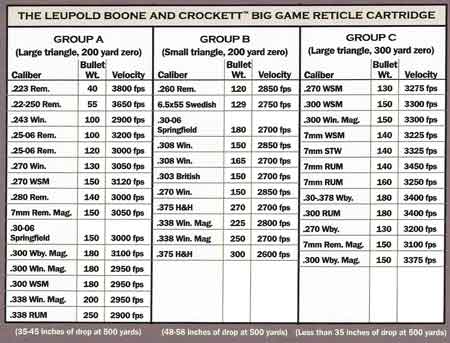
(click for a larger version)
There are three categories of cartridges and
loads in the chart. Groups A and B are for cartridges that use a
200 yard zero, and group C uses a 300 yard zero. For instance,
if you shoot a .270 Winchester with a 130 grain bullet at 3050
feet per second (fps), you use the setting for group A. On the
power adjustment ring, you would use the large arrow, which is
at ten power on this scope. That makes perfect sense, because if
the deer or antelope is out far enough that you need to use the
bullet drop feature, the ten power setting is best.
Another example would be a shooter using a .308 Winchester
shooting a 150 grain bullet at approximately 2850 fps, use the
smaller arrow, since that cartridge and load falls within group
B. For high-stepping cartridges such as the magnums using light
bullets that fall into group C, you again use the large arrow.
In use, it is much easier and quicker than this lengthy
explanation would lead you to believe. The chart makes it
simple, and once you know which arrow to use, you can forget
about the chart entirely. If you are having trouble figuring out
just where your particular cartridge falls into the chart, send
me an email, and we will figure it out together.
Once you have the target sighted within
the scope, simply use the aiming point which corresponds with
the distance to the target. With most cartridges, the aiming
points will be like this:
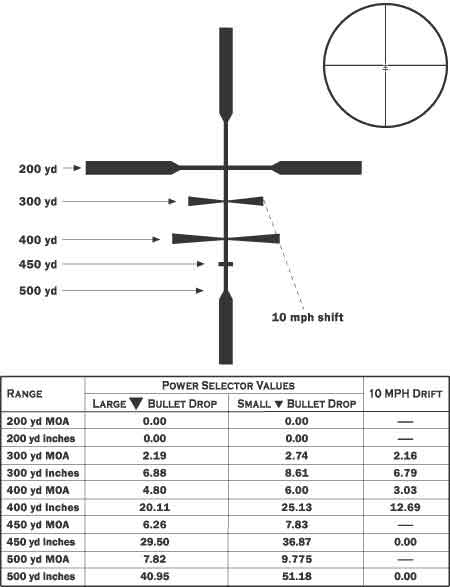
If your cartridge falls within group 3, the
crosshair will be 300 yards, with the lower aiming points
corresponding with 400, 500, 550, and 600 yards. As noted in the
picture, the 300 and 400 yard aiming points also have reference
points to allow for a ten mile-per-hour crosswind. The
windage and elevation points are very useful. While I do not
shoot game at 500 yards, I have on occasion taken deer at a bit
over 400 yards. Where I usually hunt, my farthest shot is 426
yards, and I have a good rest for the forearm. Guessing how much
air over the deerís back is 22 inches at that distance takes a
lot of practice. The aiming points in the B&C reticle make
precise aiming at 300 and 400 yards much easier. I do not
generally recommend that hunters take shots past 300 yards, as
frankly, most hunters cannot shoot accurately at 100 yards.
However, a hunter who is a skilled rifleman can cleanly take
game at extended ranges. In some areas of the western United
States, it is often necessary. The Boone & Crockett reticle
makes it easier for a good rifleman to place the shot
accurately.
Taking a digital picture through the scope, it
is difficult to show the reticle image presented to the shooter,
so I lifted this image from the Leupold website:
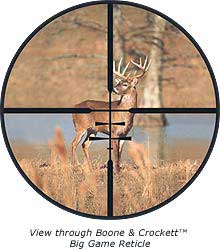
I like the B&C reticle much better than the
Ballistic-Plex reticle in my Burris Fullfield scope. I
find the Leupold reticle easier to use. My feeble attempt at
trying to describe the use of the reticle is much better
explained by the printed instructions or the CD-ROM that
accompanies the VX-III scope. I also like the turret
adjustments and optical quality of the new VX-III. It took a lot
of nerve for Leupold to replace the trusted Vari-X line of
scopes, but I find the new VX-III to be a worthy successor, and
the Boone & Crockett reticle to be a very useful aid in
helping hunters to accurately place shots at extended distances.
Accurate shot placement is the responsibility of every hunter.
Just as the Boone & Crockett Club is all about hunting, so
is this new Leupold scope, and I highly recommend it.
I briefly got to try out the Varmint Hunterís
reticle while shooting with Ruger at the 2004 SHOT Show,
and look forward to trying one out in depth later.
Check out the entire VX-III line on the web at: www.leupold.com.
Jeff Quinn
  
Got something to say about this article? Want to agree (or
disagree) with it? Click the following link to go to the GUNBlast Feedback Page.
All content © 2004 GunBlast.com.
All rights reserved. |
|
Click pictures for a larger version.
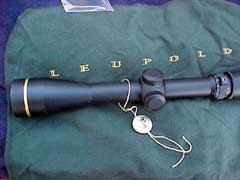
Leupold's new VX-III.

This picture, taken through the scope under poor light
conditions, shows the light-gathering ability of the VX-III.

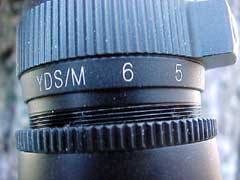
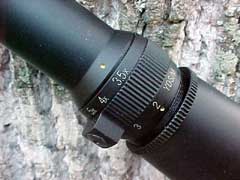
Power settings and rangefinder yardage numbers are quick
and easy to use.
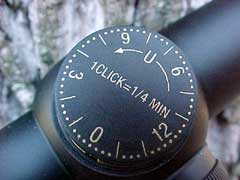
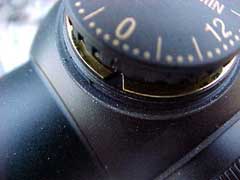
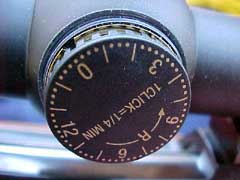
Leupold's VX-III features adjustment turrets that are
precise, positive, and easy to operate with fingers only.
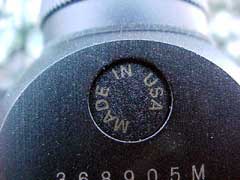
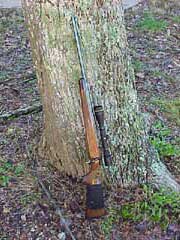
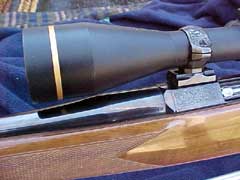
The VX-III is right at home on author's Browning A-Bolt
Medallion. The 40mm objective gathers plenty of light while
allowing a low mounting position for proper shooting
technique.
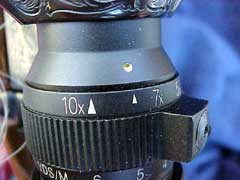
Adjustment ring is clearly marked for using the Boone
& Crockett Reticle.
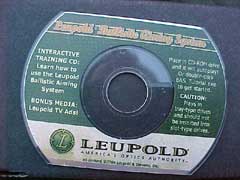
Leupold includes an interactive instructional CD-ROM.
The Ballistic Aiming System is not difficult to use, but the
easy tutorial on the CD takes all the guesswork out.
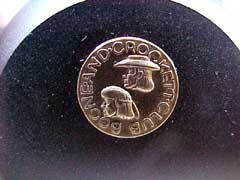
Developed with the aid of the Boone & Crockett Club,
Leupold's Boone & Crockett Reticle is a real advance in
practical field technology.
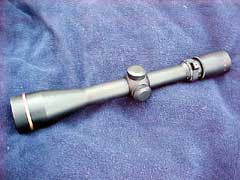
With the new VX-III, Leupold has seemingly done the
impossible - they have improved upon a classic!
|
![]()